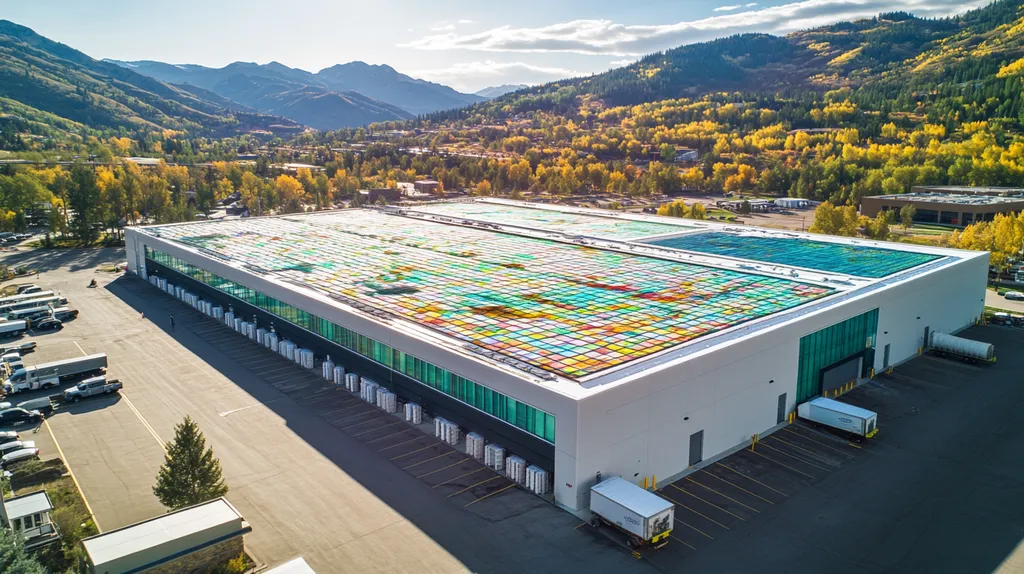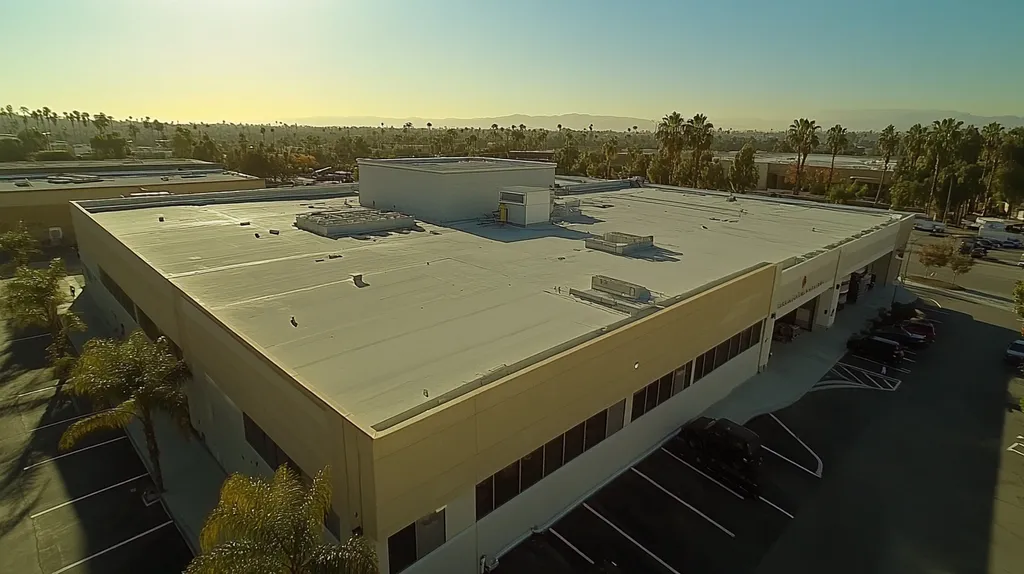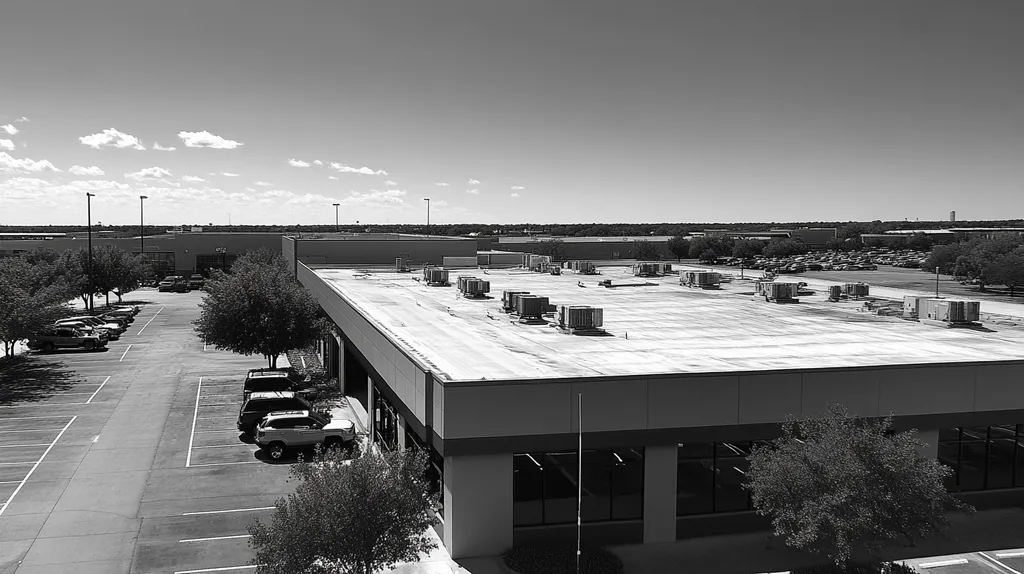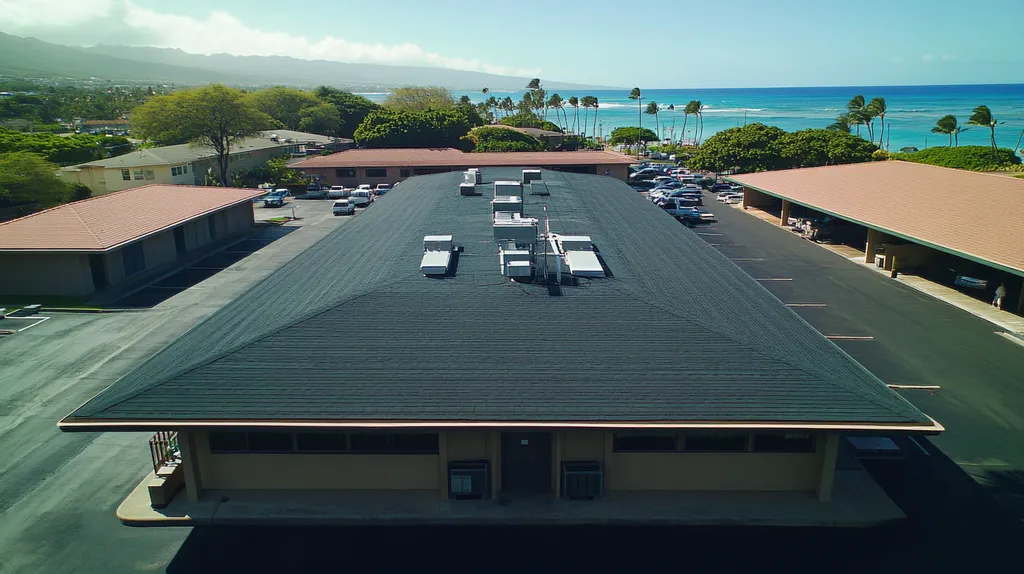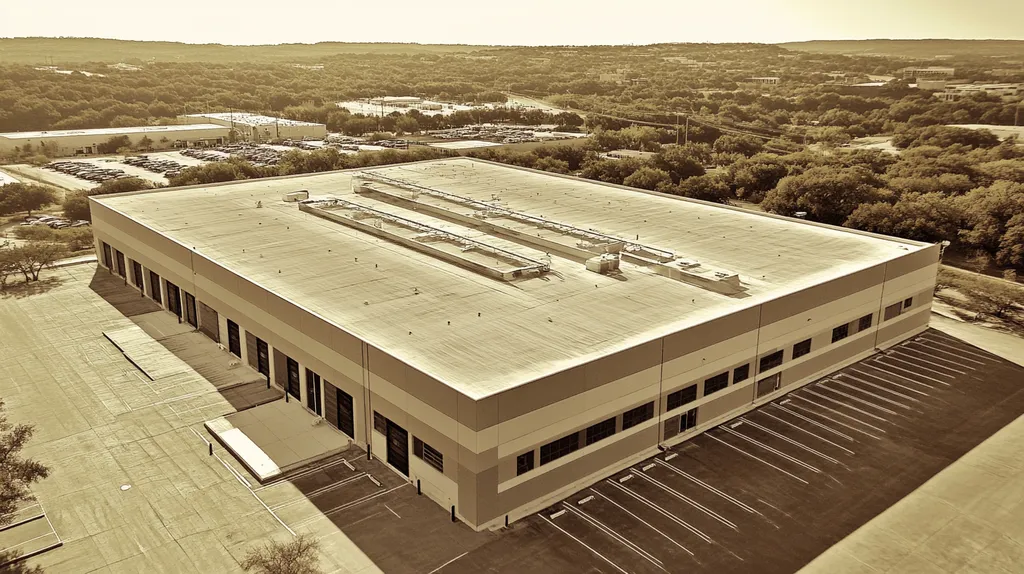Weather conditions can make or break a commercial roof coating project, with industry data showing that 40% of premature coating failures stem from poor application timing and environmental factors.
From extreme temperatures to unexpected precipitation, weather variables directly impact both immediate installation success and long-term coating performance.
For facility managers and building owners, understanding these critical weather-coating relationships can mean the difference between a roof system that lasts 15+ years and one that fails within months.
This guide examines how climate conditions affect commercial roof coatings and provides actionable insights for maximizing coating investments across varying weather challenges.
SECTION 1: THE BASICS EXPLAINED
Weather conditions can make or break a commercial roof coating project, directly impacting both immediate success and long-term performance. Industry data shows that improper application timing leads to premature coating failures in 40% of cases, resulting in costly repairs and reduced protection. Understanding the critical relationship between weather patterns and coating performance helps property owners maximize their investment while ensuring optimal roof protection.
What It Is (In Plain Language)
Commercial roof coatings are specialized protective layers that shield building surfaces from environmental damage. These coatings create a seamless membrane that prevents water infiltration while reflecting harmful UV rays.
The effectiveness of these protective systems depends heavily on weather conditions during application. Temperature, humidity, and precipitation all play crucial roles in how well the coating bonds to the roof surface.
Different coating types respond uniquely to weather conditions. Some materials require specific temperature ranges for proper curing, while others may need particular humidity levels to achieve optimal adhesion.
Understanding these weather-dependent characteristics helps property owners choose the right coating system and application timing for their specific climate zone.
Why It Matters (To Your Building)
The weather plays a significant role in the health and longevity of commercial roofs, with extreme conditions potentially leading to premature coating failure and expensive repairs. From intense UV exposure to heavy precipitation, weather elements constantly challenge roofing system integrity. (source: Castagra)
Proper coating application under ideal weather conditions creates a robust protective barrier that extends roof life. This barrier prevents moisture infiltration while managing thermal stress from daily temperature fluctuations.
Poorly timed applications can result in adhesion failures, leaving buildings vulnerable to water damage and increased energy costs. Even small compromises in coating integrity can lead to significant problems over time.
The financial implications of weather-related coating failures extend beyond repair costs to include potential business interruptions and damaged inventory.
How It Works
Roof coatings form protective barriers through chemical curing processes that are highly sensitive to environmental conditions. Temperature affects how quickly coatings cure and how well they bond to the substrate.
Humidity levels influence the rate of moisture evaporation during curing. Too much humidity can trap moisture within the coating, while too little can cause it to dry too quickly and compromise adhesion.
Wind conditions impact application consistency and can affect coating thickness. Strong winds can also carry debris that compromises the coating’s integrity during application.
Successful coating projects require careful monitoring of weather forecasts and conditions. Professional contractors use specialized equipment to measure surface temperature, ambient conditions, and dew point to ensure optimal application timing.
Modern coating technologies often include weather-specific formulations designed for different climate zones, allowing for better performance in challenging conditions.
SECTION 2: PRACTICAL APPLICATIONS
Weather conditions play a decisive role in commercial roof coating success, with proper timing and application methods directly impacting building protection. Research indicates that weather-related coating failures account for 35% of premature roof replacements, making weather awareness crucial for property owners. Understanding practical applications and timing helps facilities managers protect their investments while maximizing coating performance across varying climate conditions.
Common Uses & Examples
Commercial roof coatings serve multiple critical functions in building protection. Heavy rainfall can expose weaknesses in roofing systems, with water seeping into small cracks and seams, leading to leaks and structural damage. Prolonged sun exposure causes significant material degradation through UV radiation, resulting in cracking, blistering, and surface thinning. (source: Castagra)
Reflective coatings provide essential UV protection while reducing cooling costs. White or light-colored coatings can decrease roof surface temperatures by up to 50°F, extending material lifespan and improving building energy efficiency.
Waterproof coating systems create seamless barriers against moisture infiltration. These protective layers are particularly vital in regions experiencing frequent precipitation or areas prone to standing water.
Different coating types offer specialized protection for specific climate challenges. Silicone coatings excel in high-moisture environments, while acrylic systems perform well in moderate climates with limited rainfall.
When You Need It Most
Timing roof coating applications requires careful consideration of seasonal weather patterns. Spring and fall typically offer ideal application conditions with moderate temperatures and lower humidity levels.
Emergency coating applications become necessary after severe weather events or when existing roof systems show signs of deterioration. Quick response with appropriate coating solutions can prevent minor issues from escalating into major problems.
Pre-season coating applications help prepare roofs for upcoming weather challenges. Winter preparation requires completion before temperatures drop below coating cure thresholds.
Monitoring weather forecasts becomes crucial during application planning. Most coating systems require 24-48 hours of stable conditions for proper curing, making accurate weather prediction essential for project success.
Interactions With Other Systems
Roof coatings must work in harmony with existing drainage systems. Proper slope and drainage patterns ensure water moves efficiently off coated surfaces, preventing ponding that could compromise coating integrity.
HVAC units and roof penetrations require special attention during coating applications. These areas often experience higher wear and may need reinforced coating systems to maintain protection.
Building ventilation systems impact coating performance through moisture management. Proper ventilation helps prevent condensation buildup under the coating membrane, reducing the risk of adhesion failures.
Solar panel installations and green roof systems require specialized coating considerations. These additional rooftop features must integrate seamlessly with the coating system while maintaining their intended functions.
SECTION 3: KEY TERMINOLOGY DECODED
Clear understanding of roofing terminology directly impacts project success and building protection. Research shows that terminology confusion leads to 30% of coating failures through incorrect product selection or application methods. For facility managers and property owners, mastering essential terms, measurements, and industry language ensures better decision-making and helps avoid costly mistakes that can compromise roof integrity.
Essential Terms Explained
UV radiation poses a significant threat to commercial roofs, causing structural weakening, cracks, and compromised waterproofing. Membrane materials like TPO, PVC, and modified bitumen are particularly vulnerable to UV damage, which can lead to drying, fissures, and eventual failure. Thermal expansion from extreme heat can cause seams to separate and flashings to loosen, creating potential entry points for water. (source: Kodiak Roofing)
Understanding coating elasticity becomes crucial in areas with significant temperature fluctuations. Elastomeric coatings maintain flexibility across temperature ranges, expanding and contracting with the roof substrate to maintain protection.
Reflectivity ratings indicate a coating’s ability to reflect solar radiation. Higher reflectivity numbers translate to better heat rejection and improved building energy efficiency.
Adhesion strength measures how well a coating bonds to the roof surface. Poor adhesion leads to coating separation and premature system failure, making this characteristic vital for long-term performance.
Industry Jargon Translated
Surface preparation terminology often confuses property owners but significantly impacts coating success. Terms like “profile depth” and “surface tension” directly affect how well coatings adhere to different roof materials.
Understanding “mil thickness” specifications ensures proper material coverage. Too thin applications compromise protection, while excessive thickness wastes materials and can lead to curing problems.
Cure time refers to how long coatings need to reach full strength. This varies by product type and weather conditions, making it essential for project planning.
Vapor transmission rates indicate how well coatings manage moisture movement. This becomes particularly important in humid climates or buildings with high interior moisture levels.
Measurement & Units Simplified
Coverage rates typically appear in gallons per square (100 square feet). Understanding these measurements prevents material shortages that could delay project completion.
Slope measurements use ratios or degrees to indicate roof pitch. These measurements help determine appropriate coating types and application methods for different roof configurations.
Temperature specifications include both ambient and surface requirements. Following these ranges ensures proper coating cure and maximum performance.
Humidity levels, measured as relative humidity percentage, affect coating application and curing. Optimal ranges vary by product type but typically fall between 40-85% for most systems.
SECTION 4: DECISION FACTORS
Weather conditions dramatically impact commercial roof coating decisions, with improper choices leading to premature system failures and extensive repair costs. The complexity of modern roofing systems, combined with increasingly volatile weather patterns, makes selecting appropriate coating solutions critical for building protection. Property owners must carefully evaluate multiple factors to ensure their coating investment delivers optimal performance and longevity in their specific climate conditions.
Cost Considerations
Weather conditions can take a severe toll on commercial roofs, with extreme temperatures, UV exposure, and precipitation all contributing to accelerated deterioration. From surface cracking to membrane separation, weather-related damage significantly impacts both immediate repair costs and long-term maintenance requirements. (source: Castagra)
Initial coating costs typically range from $2-8 per square foot, with premium weather-resistant options commanding higher prices. However, these upfront investments often translate to reduced maintenance expenses and extended service life.
Labor costs vary significantly based on application timing and weather conditions. Poor weather can extend project timelines, increasing overall installation expenses through additional labor and equipment charges.
Energy savings from weather-appropriate coatings can offset initial costs. Reflective coatings in hot climates can reduce cooling expenses by 15-25%, while proper insulative coatings in cold regions minimize heat loss.
Performance Trade-offs
Different coating types offer varying levels of weather resistance, requiring careful evaluation of local climate patterns. Single-component systems may provide adequate protection in mild climates but often fail prematurely in severe weather conditions.
UV resistance and thermal stability often compete with moisture management capabilities. High-solids coatings excel at UV protection but may struggle with vapor transmission in humid environments.
Application temperature ranges limit when certain coatings can be installed effectively. Some systems require specific temperature and humidity conditions for proper curing, restricting application windows.
Wind resistance capabilities become crucial in exposed locations. Higher-build systems offer better wind protection but may require longer cure times and specific weather conditions during installation.
Lifespan & Durability Factors
Weather exposure directly impacts coating longevity, with harsh conditions accelerating degradation. Properties in extreme climate zones often require more frequent recoating or enhanced maintenance programs.
Material thickness and reinforcement options affect weather resistance. Thicker applications generally provide better protection but must be balanced against proper cure requirements and cost considerations.
Surface preparation requirements become more critical in challenging weather conditions. Proper cleaning and primer selection significantly impact coating adhesion and long-term performance.
Warranty coverage often depends on weather-appropriate installation practices. Many manufacturers require specific application conditions and maintenance programs to maintain warranty protection.
SECTION 5: COMMON CHALLENGES
Weather-related challenges pose significant risks to commercial roof coating projects, with improper application conditions leading to coating failures in up to 40% of installations. Even minor environmental disruptions during application can compromise coating integrity, leading to premature deterioration and expensive repairs. Understanding and proactively addressing these challenges helps property owners protect their investment while ensuring optimal coating performance.
Frequent Problems & Solutions
The success of roof coating applications depends heavily on environmental conditions during installation, with temperature, humidity, and wind speed directly impacting performance and durability. Higher humidity levels can significantly slow drying times and increase the risk of moisture entrapment, while strong winds can introduce contaminants and cause uneven coating distribution. (source: Armour Roof Coatings)
Temperature extremes present significant application challenges. Cold temperatures can prevent proper curing, while excessive heat may cause the coating to dry too quickly, compromising adhesion and overall performance.
Surface moisture from dew, rain, or high humidity creates adhesion problems. Implementing proper moisture detection protocols and scheduling applications during optimal conditions helps prevent these issues.
Contamination from airborne debris requires careful surface preparation and timing. Working during calmer conditions and using appropriate barriers helps maintain coating integrity during application.
Warning Signs To Watch For
Coating blisters and bubbles indicate trapped moisture or improper curing conditions. These defects typically appear shortly after application and require immediate attention to prevent spreading.
Uneven coating thickness suggests application problems related to temperature or wind conditions. Regular thickness measurements during application help identify and correct these issues.
Surface crazing or micro-cracking often results from improper cure temperatures. These early warning signs require prompt investigation to prevent coating failure.
Color variations or streaking indicate inconsistent application or curing conditions. Proper environmental monitoring and application techniques help prevent these aesthetic and performance issues.
Preventative Approaches
Comprehensive weather monitoring protocols ensure optimal application conditions. This includes tracking temperature, humidity, wind speed, and precipitation forecasts.
Surface preparation standards must adjust for weather conditions. Different temperatures and humidity levels may require modified cleaning methods or primer selection.
Application timing strategies should account for seasonal weather patterns. Planning installations during historically stable weather periods improves success rates.
Emergency response plans help address unexpected weather changes. Having proper equipment and materials ready for sudden condition changes protects incomplete applications.
SECTION 6: NEXT STEPS & RESOURCES
Weather considerations dramatically impact commercial roof coating success, with poor timing decisions leading to premature failures in 45% of installations. Extreme temperatures, prolonged UV exposure, and heavy rainfall create significant challenges for coating integrity. From material degradation to water infiltration, these environmental factors can severely compromise roofing systems and lead to extensive damage, making proper planning and resource utilization essential for long-term protection.
Questions To Ask Providers
UV radiation poses significant threats to commercial roofs, causing structural weakening, surface cracking, and compromised waterproofing. High temperatures trigger thermal expansion and contraction cycles that stress roofing materials, while heavy rainfall exploits minor imperfections, leading to water infiltration and structural damage. (source: Castagra)
Request detailed explanations of their coating selection process based on local climate patterns. Understanding how contractors evaluate weather data ensures appropriate material choices for specific environmental challenges.
Inquire about their surface preparation protocols for different weather conditions. Proper preparation becomes increasingly critical as temperature and humidity fluctuations impact coating adhesion.
Discuss their quality control measures during application. Professional contractors should demonstrate clear procedures for monitoring environmental conditions and adjusting application techniques accordingly.
Verify their emergency response capabilities for unexpected weather events. Having established protocols for protecting incomplete applications can prevent costly failures.
Industry Standards & Guidelines
The NRCA and ASTM provide comprehensive guidelines for weather-appropriate coating applications. These standards establish minimum requirements for material performance and installation procedures across varying climate conditions.
Building codes specify requirements for coating resistance to local weather patterns. Understanding these regulations ensures compliance while maximizing protection against regional climate challenges.
Energy efficiency standards influence coating selections, particularly in extreme temperature zones. Meeting these requirements helps optimize building performance while maintaining proper protection.
Quality control specifications outline testing procedures for weather resistance. Regular inspections following these guidelines help identify potential issues before they become major problems.
Further Learning Simplified
Professional organizations offer specialized training programs focused on weather-related coating challenges. These resources provide practical knowledge for managing climate impacts on roofing systems.
Technical bulletins from manufacturers detail weather-specific application guidelines. Staying current with these publications ensures awareness of latest best practices and material innovations.
Regional roofing associations conduct workshops addressing local climate challenges. These events offer valuable networking opportunities while providing targeted solutions for specific weather conditions.
Online resources provide real-time weather monitoring tools and forecasting specifically for roofing applications. Understanding and utilizing these tools helps optimize project timing and coating performance.
The Bottom Line
With 40% of commercial roof coating failures directly linked to weather-related issues, understanding and adapting to climate conditions isn’t optional – it’s essential for building protection.
Professional weather monitoring, proper material selection, and precise application timing can extend coating life by 15+ years, while poor planning often leads to system failure within months.
The financial stakes are significant: weather-appropriate coating systems can reduce energy costs by up to 25% and prevent thousands in water damage repairs.
For facility managers and building owners, success lies in partnering with qualified contractors who understand local climate patterns and maintain strict weather-based application protocols.
The future of commercial roof protection depends on this critical balance between material science and environmental awareness.
FREQUENTLY ASKED QUESTIONS
Q. How do weather conditions affect commercial roof projects?
A. Weather conditions play a critical role in the success of commercial roof projects. Temperature, humidity, and precipitation can directly impact how well the coating adheres and cures. Applying coatings in unsuitable weather can lead to premature failures and costly repairs.
Q. When is the best time for commercial roof coating applications?
A. Spring and fall are generally considered the best times for commercial roof coatings. During these seasons, temperatures and humidity levels are often more moderate, creating ideal conditions for proper application and curing, thus ensuring long-lasting protection for the roof.
Q. What are some common terms related to commercial roofs?
A. Terms like adhesion strength, UV resistance, and cure time are crucial in roofing. Understanding these terms helps property owners select the right materials and installation processes. Clear terminology can avoid costly mistakes and ensure optimal roof protection.
Q. What factors should I consider for roof coating decisions?
A. Consider the local climate, coating material type, and application timing. Each factor impacts long-term performance and protects against environmental challenges. Making informed decisions ensures your coating investment effectively prolongs the roof’s lifespan.
Q. What are common challenges during roof coating?
A. Temperature extremes and high humidity can significantly impact coating application. These conditions may lead to adhesion problems and extended drying times. Addressing these challenges proactively helps maintain coating integrity and prevent premature failures.
Q. What questions should I ask roof coating providers?
A. Ask about their coating selection process and how they prepare surfaces under varying weather. Understanding their quality control measures during application ensures that your roof receives appropriate protection against environmental factors.
Q. How can I improve the longevity of my commercial roof coating?
A. Regular inspections and timely repairs can dramatically improve the longevity of your roof coating. Consider environmental factors such as UV exposure and temperature fluctuations when planning maintenance, ensuring optimal protection throughout the roofing system’s lifespan.

